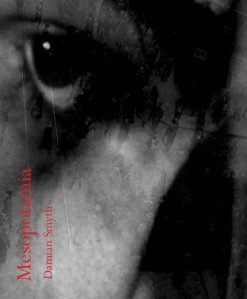Mesopotamia, Damian Smyth, Templar Poetry 2014, £10.00
reviewed by Richie McCaffery
The scale and historical sweep of this collection, from ancient history to the violence of the Troubles, reminded me most of Hamish Henderson’s WW2 sequence Elegies for the Dead in Cyrenaica. The tone of Smyth’s poems too shares something of the coolness and rhetoric of Henderson’s elegies which melded a modern mechanised war with the death cults of ancient civilisations. Smyth seems to be doing something similar here, in ‘On the Inscriptions at Van’ where a mummy is shipped over to a museum in Ireland in the mid 1900’s:
For all her enchantments,
her name and her prayers
and disappointing tattoos
like some drowned sailor,I might have seen her,
bony and wasted,
her womb and heart raided
in the Down infirmary.
Poetry such as this is not to be entered into lightly for entertainment’s sake alone, it often offers a didactic and, at its best, transformative experience. These poems surround the reader with the presence of the past and the immediacy of ancient and recent strife and the triumph of poetry in a war-zone which is so antipathetic to its creation in the first place. Now and again I heard echoes of Geoffrey Hill in these poems, often in taking a simple image and making it new by cloaking it in unusual diction: “an engine’s rough berceuse” in the poem ‘Obituary’, for instance.
Reading these poems, I have no doubts about the serious intentions of Smyth as an artist, but I kept feeling that some of his imagery was just a little bit too easy and kitchen-sink, such as “Downpatrick weather. Mist over the swamp / grey as widows’ washing strung on a hedge”. I can picture this image well, but I cannot believe in it. This is the same when the pained cries of a heifer with a broken back are compared to the noise of “dishevelled wind instruments” – a striking image, for sure, but not up the task in terms of intensity and like the image of the girl killed in a car-crash “found pressed to the windscreen like a starfish”. Other times Smyth often re-uses tropes such as the “asterisks” of spilled blood or comparing (as George Mackay Brown did) gravestones to boat sails. That said, these poems now and again scintillate with an unexpected image, as in the title poem where:
(…) For a moment along the River Quoile the beeches
are so big in autumn, so blown, they are like high-rise buildings
with all the lights on (…)
Mesopotamia is a richly layered and researched collection, it even contains a bibliography and list of further reading, which shows something of the edifying aspects of Smyth’s poetry. Scottish poet Alan Riach has recently argued that the arts “teach us how to live” and Smyth’s poems seem to offer case-studies on ways in which lives have been lived and wasted, hinting all the time at how they can be bettered. Hamish Henderson in his sequence spends a lot of time arguing that we put so much of “our human iron” into fighting and pursuing death and the subtext to Mesopotamia is the life and times of Orientalist Rev. Edward Hincks who spent much of his life trying to decipher the hieroglyphs of a culture that spent its time and energy on war and death. Smyth positions himself well to chronicle vanishing eras of social and national history, but his poetry refuses to offer any simple or glib answers on the nature of how we live, engage with other cultures and protect our notions of ‘home’:
It’s more a new exhaustion borne from peace
which must be endured; this trope; the pretence
that when violence subsides there is ease
and plenty, just reward for innocence.(…)
There will be killing: just done differently
and more slowly and by a different name.
[‘Lapis Lazuli’]
Richie McCaffery
http://ninearchespress.com/publications/poetry-collections/cairn.html

